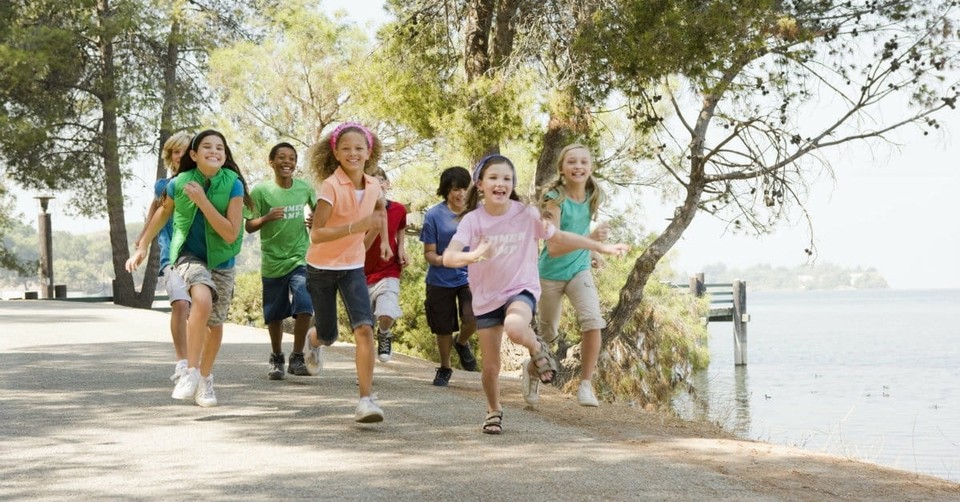8 Ways to Help Your Children Play and Learn

Here in South Africa we cannot imagine a lifestyle where children are not outdoors most of the time. Some of my friends who come from other countries have told me how it took them a long time to get into the mindset that the “place for children to play is outside—not inside.” The great advantage of the outside is that one needs far less toys for entertainment. It never ceases to amaze me how children really play with almost nothing when they are outdoors. As long as there is a three-dimensional space where they can move forwards and backwards, run, hop, jump, and climb to move up and down (as in trees)—if you then add a bit of soil, sand, and water together with a few sticks and stones and leaves and stuff—children will never be bored!
Our children here in South Africa grow up outside...with bare feet on grass, mud play, tree climbing and sunshine all year ’round! It is a privilege we mostly appreciate when our children get fidgety by the hour in those rare times of continuous rain for three days. Charlotte Mason encourages being in nature, doing what she calls “nature study,” which is quite natural for children to do if they are out in nature a lot. If you do not have your own backyard, then do put in some extra effort to get into nature as much as possible by going to a park or forest or beach or even a neighbor’s yard. For now I am going to assume that most of the readers have access to their own nature area, and I’ll give some practical ideas to set up an outdoor environment for keeping children of all ages productively busy (from baby phase to teenager phase).
First, ensure that the basics are available: open grass, water, soil, sand, trees, and rocks. Trees will be even more enjoyable if they are of the sort one can climb. Water does not have to be a swimming pool, and when children are small, even just a bucket filled with some water is sufficient; water features, such as fountains, are also very entertaining and relaxing. If you have these basics, living things such as insects, birds, lizards, spiders, etc. will quickly inhabit your backyard, making it an outdoor observatory for nature study.
Add interesting play, provoking things such as a climbing frame, swings (homemade ones can be made, e.g., knotted ropes or a tire fastened with ropes), a tree house, tires, bamboo, a hose pipe, and pets.
Provide an area where they can roller skate or ride bikes or practice throwing a ball through a loop. Set up a net for kicking a ball into.
Involve your children from a young age in helping you when you have your own vegetable or herb garden, flowers, bonsais, orchids, or whatever your green thumbs like to grow. If you are an animal lover, all sorts of pets and other small animals can provide lots of learning opportunities for caring and can even develop into a business later, e.g., raising birds, chickens, etc.
There are so many opportunities for productive (paid) work in a garden; you can decide if you want to add them as basic chores or regard them as “extra,” paid chores. Mowing and maintaining the lawn; varnishing wooden structures, chairs, tables, or other furniture; painting permanent structures; annual tree planting or trimming; adding fertilizer on regular basis to grass or beddings; cleaning the fish pond; raking up autumn leaves; and weeding flowerbeds are examples of outside chores that children can carry out successfully—and they’re fun too! Projects for older children could include building a tree house, swings, ladders, and structures for imaginary play, e.g., boats, tents, prisons.
Do things outside regularly: have picnics lunch or dinner outside, do art outside, read on a blanket or a swing or on the grass, have tea under a tree, play badminton, play ball games, pitch a tent and camp in your backyard with a real fire to cook a meal on, watch the stars and seek out constellations, or study the moon’s cycle for a month.
Teach your children observational skills as you do this yourself. For example, highlight changes in seasons and nature every time you are outside; watch the leaves fall; experience the warmth, the cold, changes in light, length of day, and how much the wind is blowing; and observe how much or little rain falls and then talk about God’s design for seasons of growth and rest. Learn to observe weather in all its forms. Matthew 6:28 (AMP) says, “Consider the lilies of the field and learn thoroughly how they grow.”
Intentionally let nature study be part of “school”—apart from conducting science experiments outside, have your child prepare a speech/report about your own bird gardens as part of your science studies, or do a work project when trying to attract birds to the garden, e.g., building a feeder, or teach your children how to prepare the garden soil for the new planting season—as you do it together.
Being outdoors is healthy and good and provides many informal learning opportunities with little effort! Both children and adults will benefit from being outdoors more. I truly believe God is revealing to us His character, wisdom, and wonder in nature, so getting out in nature often will have an impact on our souls and spirits. You will not be untouched when you “look out for God” in nature. Let us help our children also to have this experience as we allow them outdoor fun!
“The meadows are clothed with flocks, the valleys also are covered with grain; they shout for joy and sing together” (Psalm 65:13, AMP).
Five Rules for Moms When Children Are Outside
1. Let them get dirty! This is very important, and it will prevent grief (yours, not theirs) if you dress them appropriately beforehand.
2. Allow them some time to get into the play, even if it takes a while. Sometimes they need to warm up a bit before they really start to build “that dam” you suggested.
3. Allow them to do what they want to do. Sometimes they just want to sit a while on the swing. That is okay. Offer them that quiet time.
4. Encourage them to collect things. This is a hard one, and I agree that one should have limits and rules, e.g., snakes are not allowed in the house and spiders cannot roam free.
5. Permit them to explore and experiment with nature. This does not include allowing them to torture or destroy any animal or plant, but do allow them the odd breaking of a rock to see what is inside or carefully taking apart a flower or seed to analyse the intricate design for themselves.
I (Willemien Kruger) love the season of life I now live, as a South African homeschool mother of three precious children and happily married. I love to research and read wholesome, intelligent, and value-adding information, and I enjoy sharing what I learn. Find support to continuously improve your homeschool on my website, pointing YOU in the right direction, whether you are just starting out or have been doing this for a while.
Copyright 2012, used with permission. All rights reserved by author. Originally appeared in the June 2012 issue of The Old Schoolhouse® Magazine, the family education magazine. Read the magazine free at www.TOSMagazine.com or read it on the go and download the free apps at www.TOSApps.com to read the magazine on your mobile devices.
Publication date: April 11, 2014
Originally published November 20, 2017.







